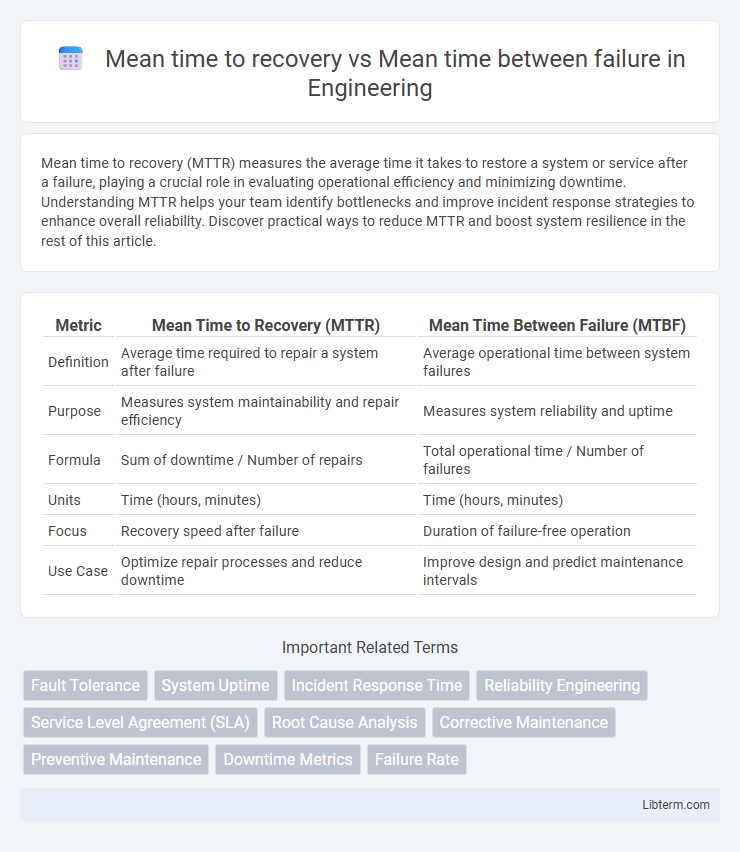Mean time to recovery (MTTR) measures the average time it takes to restore a system or service after a failure, playing a crucial role in evaluating operational efficiency and minimizing downtime. Understanding MTTR helps your team identify bottlenecks and improve incident response strategies to enhance overall reliability. Discover practical ways to reduce MTTR and boost system resilience in the rest of this article.
Table of Comparison
| Metric | Mean Time to Recovery (MTTR) | Mean Time Between Failure (MTBF) |
|---|---|---|
| Definition | Average time required to repair a system after failure | Average operational time between system failures |
| Purpose | Measures system maintainability and repair efficiency | Measures system reliability and uptime |
| Formula | Sum of downtime / Number of repairs | Total operational time / Number of failures |
| Units | Time (hours, minutes) | Time (hours, minutes) |
| Focus | Recovery speed after failure | Duration of failure-free operation |
| Use Case | Optimize repair processes and reduce downtime | Improve design and predict maintenance intervals |
Introduction to MTTR and MTBF
Mean Time to Recovery (MTTR) measures the average time required to repair a system and restore it to full functionality after a failure occurs. Mean Time Between Failure (MTBF) indicates the average operational time between consecutive system failures, reflecting overall reliability. MTTR and MTBF are critical metrics in reliability engineering and maintenance management, providing insights into system performance, downtime reduction, and maintenance efficiency.
Defining Mean Time to Recovery (MTTR)
Mean Time to Recovery (MTTR) quantifies the average duration required to restore a system or component after a failure, encompassing detection, diagnosis, repair, and restoration activities. It is a critical metric in reliability engineering and IT service management, directly impacting system availability and operational continuity. MTTR differs from Mean Time Between Failures (MTBF), which measures the average operational time between consecutive failures, emphasizing the importance of rapid recovery in minimizing downtime.
Understanding Mean Time Between Failure (MTBF)
Mean Time Between Failure (MTBF) measures the average time elapsed between system breakdowns, serving as a key indicator of reliability and system durability in industries like manufacturing, IT, and telecommunications. Unlike Mean Time to Recovery (MTTR), which focuses on the duration to restore a system after failure, MTBF emphasizes the expected operational uptime and helps in planning maintenance schedules to minimize disruptions. High MTBF values indicate longer intervals of uninterrupted performance, guiding asset management decisions and improving overall system efficiency.
Key Differences Between MTTR and MTBF
Mean Time to Recovery (MTTR) measures the average time required to repair a system or component after a failure, highlighting system maintainability and responsiveness. Mean Time Between Failure (MTBF) calculates the average operational time between two consecutive failures, emphasizing system reliability and uptime. Key differences include MTTR focusing on downtime duration for restoration, while MTBF centers on the interval of uninterrupted operation.
Importance of MTTR in Incident Management
Mean Time to Recovery (MTTR) measures the average time required to repair a system after a failure, highlighting its critical role in minimizing downtime during incident management. Lower MTTR directly translates to faster incident resolution, which ensures higher system availability and improved user satisfaction. While Mean Time Between Failure (MTBF) indicates reliability by measuring the average operational time between failures, MTTR focuses on the efficiency of response and recovery processes essential for maintaining business continuity.
The Role of MTBF in Reliability Engineering
Mean Time Between Failure (MTBF) plays a critical role in reliability engineering by quantifying the average operational time between inherent system failures, serving as a key performance indicator for system durability and maintenance scheduling. Unlike Mean Time to Recovery (MTTR), which measures the average time required to repair and restore a system after failure, MTBF focuses on the prediction and prevention of failures to maximize uptime. Robust reliability strategies leverage MTBF to design maintenance intervals and optimize asset lifecycle management, thereby reducing downtime and improving operational efficiency.
MTTR and MTBF Calculation Methods
Mean Time to Recovery (MTTR) is calculated by dividing the total downtime by the number of failures, measuring the average time required to restore a system after a failure. Mean Time Between Failure (MTBF) is determined by dividing the total operational uptime by the number of failures, representing the average interval between system failures. Accurate MTTR and MTBF calculations help organizations optimize maintenance schedules and improve system reliability.
Impact of MTTR and MTBF on System Performance
Mean Time to Recovery (MTTR) directly influences system availability by determining the speed at which a system is restored after failure, thereby minimizing downtime and improving operational continuity. Mean Time Between Failures (MTBF) reflects system reliability by measuring the average operational time before a failure occurs, impacting maintenance scheduling and resource allocation. Optimizing both MTTR and MTBF enhances overall system performance by balancing quick recovery processes with extended intervals of uninterrupted functionality, leading to higher efficiency and reduced operational costs.
Best Practices to Improve MTTR and MTBF
Improving Mean Time to Recovery (MTTR) and Mean Time Between Failure (MTBF) requires implementing proactive monitoring systems, regular preventive maintenance, and thorough root cause analysis to quickly identify and resolve issues. Leveraging automation tools and incident response playbooks accelerates recovery processes, while continuous training and knowledge sharing enhance team readiness and system reliability. Optimizing asset health through condition-based maintenance and using real-time analytics significantly extends uptime and minimizes failure frequency.
Choosing the Right Metric: MTTR vs MTBF
Choosing between Mean Time to Recovery (MTTR) and Mean Time Between Failure (MTBF) depends on the focus of system reliability and maintenance strategy. MTTR emphasizes the efficiency of incident response and repair processes, providing insights into downtime reduction and operational resilience. MTBF measures the average operational lifespan between failures, helping to predict system stability and guide preventative maintenance planning.
Mean time to recovery Infographic

 libterm.com
libterm.com